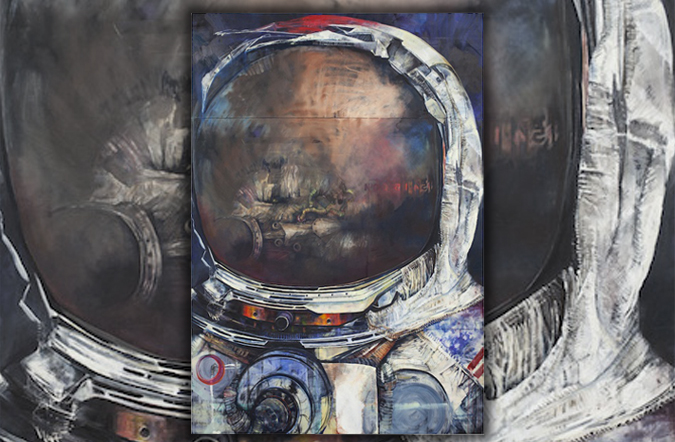Originally published in The WILD Magazine. ◊◊
“People love dioramas,†Joianne Bittle once observed, “They get emotional about them. It has something to do with making the real non-real.†Bittle is no amateur creator of full-scale environments, having worked as a dioramist for the American Museum of Natural History before she began using the skill set to create her own work. Though she has taken on many media, Bittle has a practice that is constantly inquisitive of the ways in which humankind has shaped and presented geology and chronology.
Churner and Churner’s two rooms now house Bittle’s largest solo show yet and feature a range of her multi-media works. The exhibition is anchored by its two largest pieces: Unconformity (2012), an installation of kaleidoscopically colored stalagmites and stalactites in the front window of the gallery; and Moonman V (2011-2012), a 10-foot by 7-foot portrait of an astronaut that occupies the whole back wall of the gallery, and then some (the three-paneled work is so large that the gallery was obliged to cut into its ceiling to accommodate the piece). Unconformity is an interpretation of Plato’s cave, a philosophical symbol of man’s search for knowledge, which comes to underpin the mission of Bittle’s work. Moonman V is one in a series of paintings featuring astronauts, whom she calls “pioneers in a new environment.†If Unconformity is about the pursuit of enlightenment, Moonman V, with its helmet reflecting the image of a second astronaut, demonstrates a certain self-awareness and technological mastery.
The point is driven further in the artist’s first film project titled On My Way Gone (2012), from which the exhibition borrows its name. The film is a trailing look behind a water-borne tour of a swamp and its remarkably reflective waters. On My Way Gone is presented on a monitor sitting on a pedestal angled to face Moonman V, who looks on impassively.
Between these Unconformity and Moonman V, the rest of the show reads almost chronologically as a timeline and a landscape that stretches from pre-history to the space age. The feeling of continuous flow is in part aided by Segments Frieze (2012), a 22-panel mixed-media landscape painting that spans the length of the front gallery’s wall. The space is also dotted with non-sequitur paintings like Knowing Man (2011), a modified encyclopedia page on Homo sapiens in which the illustration is replaced with a mirrored surface, and two gestural drawings of fossil-like forms titled Hallucigenia (2012) and Brachiopod (2010).
Within these close quarters, it is possible to feel the current runs through her work, bending the vines on trees and the hairs on baboons’ heads alike, and turning rocks psychedelic shades of orange-green. Churner and Churner, impressive for its constant ability to adapt its interiors into a relevant container for its artwork, looks and feels like a diorama-of-sorts in which we are specimens and participants as much as spectators.
Images courtesy of Churner and Churner and the artist.
